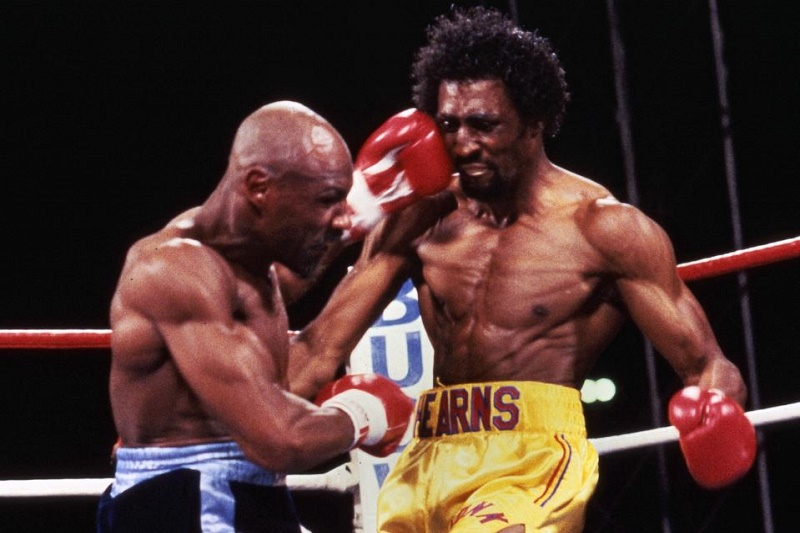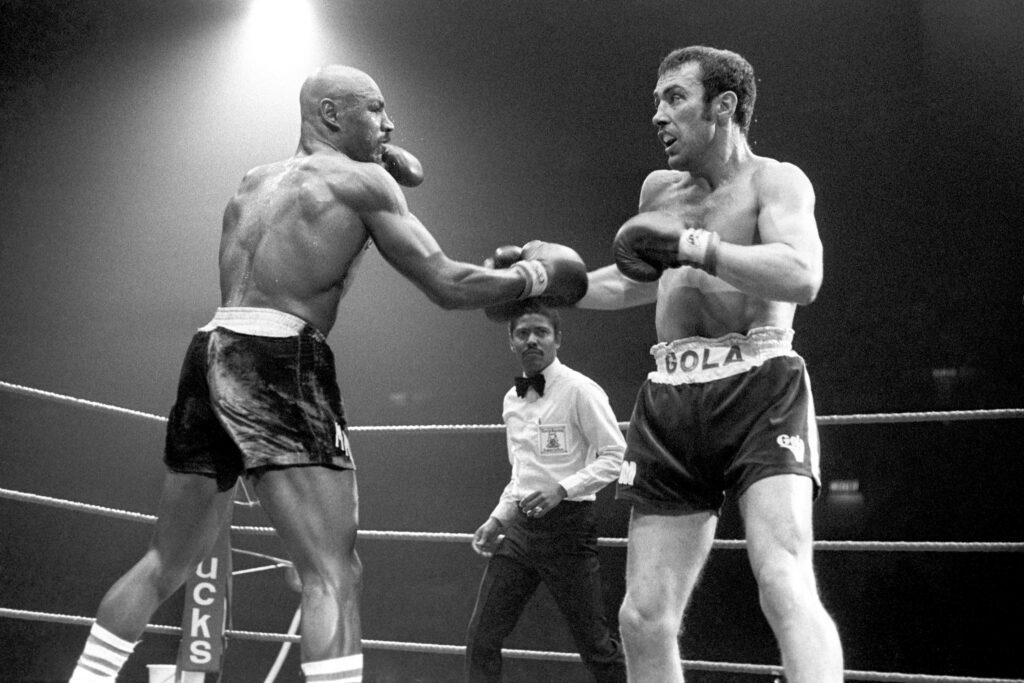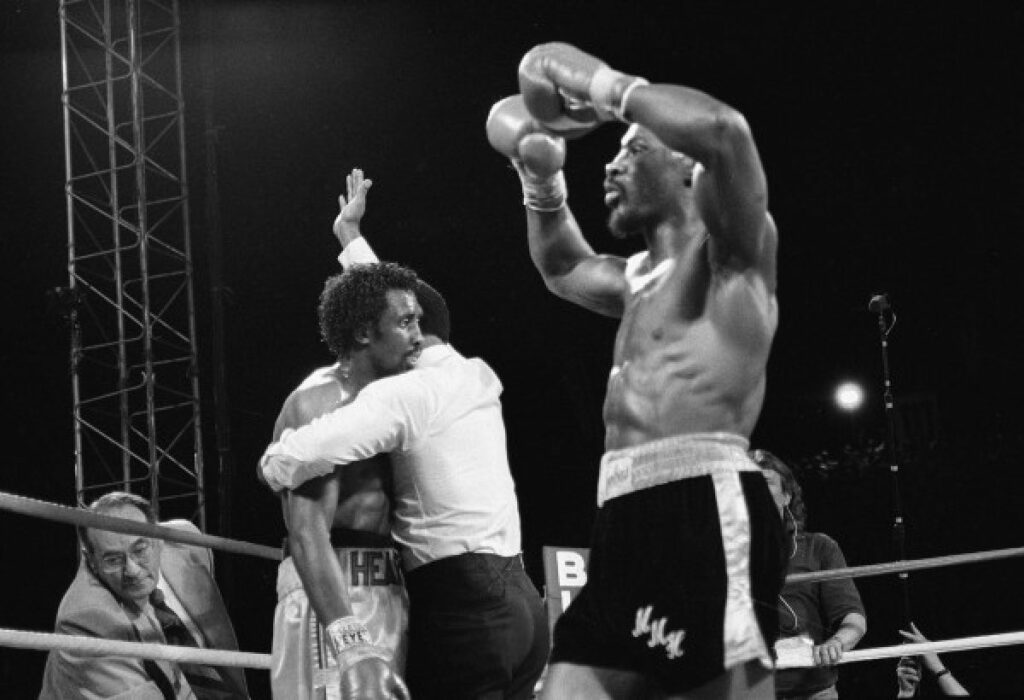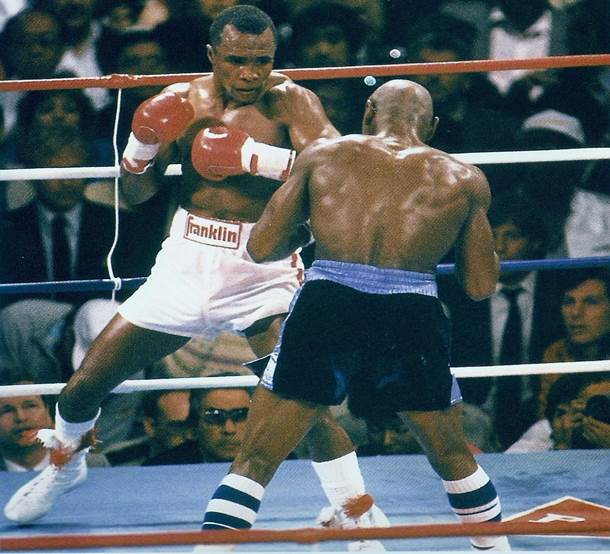IBHOF inductee Graham Houston pays tribute to legendary middleweight champion Marvin Hagler who sadly passed away this weekend.
It was because he seemed well nigh indestructible that the death of Marvelous Marvin Hagler on March 13, at the age of only 66, came as such a shock to the boxing world.
Hagler was a great fighter, one of the all-time best middleweight champions, with 12 successful defences of the title. He went undefeated for 11 years at one point in his career.
Born in Newark, New Jersey, raised in Brockton, Massachusetts, from the age of 16, Hagler was the consummate professional, totally dedicated to his craft, always superbly conditioned. No one ever outlasted Hagler. He could box, he could fight and he could punch with either hand out of his southpaw stance, although he was known to switch to the orthodox style.

And Hagler surely had one of the best chins in ring history, as he showed when standing up to hammer blows from John Mugabi and Thomas Hearns. (The only time Hagler was officially knocked down, in a title fight with Argentina’s heavy-handed Juan Domingo Roldan, was more of a slip.)
Hagler, who legally added the “Marvelous” to his name, lost only three times in his 67-fight, 14-year career, and two of those losses were debatable.
I’m not sure we will ever see the likes of Hagler again. He truly did it the hard way, taking fights against local favourites in their hometowns. This included a series of fights in Philadelphia, where he lost decisions to Bobby “Boogaloo” Watts (a controversial verdict) and Willie “The Worm” Monroe, although he knocked out both — Monroe twice — in rematches. Hagler boxed a draw with Olympic gold medallist Sugar Ray Seales in Seales’ hometown of Seattle, Washington, after having defeated Seales by decision in Boston. In a third meeting, Hagler destroyed fellow-southpaw Seales in the opening round.
A US amateur champion before turning professional in 1973, Hagler stayed with manager-trainer duo Pat and Goody Petronelli throughout his career and he also stuck with Bob Arum, who promoted him throughout Hagler’s championship reign. This sort of loyalty is rare to find in today’s boxing environment.
Hagler worked in construction for eight years before he was able to box professionally full-time. “I was the best cement worker in Massachusetts,” he told columnist Red Smith in a 1980 interview. He was raised by a single mother, who moved with her six children to Massachusetts in 1970 after the race riots that swept Newark in the late 1960s.
Goody Petronelli was Hagler’s first and only trainer. Hagler started boxing at a gym run by the Petronellis in Brockton. It wasn’t long before the Petronelli brothers realised they had a special talent in Hagler.
By the time Hagler was fighting in Philadelphia in the late 1970s he had developed into a formidable fighting machine. A crowd of almost 15,000 saw Hagler defeat the highly regarded, super-tough hometown favourite Bennie Briscoe in Philadelphia in August 1978. In a 1980 interview with the now-defunct Boxing Today magazine, Hagler talked of a meeting with heavyweight great Joe Frazier in Philadelphia. “We talked and I’ll never forget what he told me. He said: ‘You’ve got three strikes against you. You’re black. You’re a southpaw. And you’re good.’”
And Hagler certainly was good. He was considered the uncrowned middleweight champion for years and a 4/1 on betting favourite when he challenged Vito Antuofermo for the title at Caesars Palace, Las Vegas in November 1979. The bout ended in a 15-round draw but Hagler seemed to have won clearly. Antuofermo crowded forward but suffered an assortment of cuts. Sports Illustrated called the decision “astonishing”.

Having to leave Las Vegas without the title he believed he had won was a bitter pill for Hagler, who vowed that when he next got a title opportunity he wouldn’t let the fight go to a decision. Nor did he when won the championship at the second attempt, stopping fellow-southpaw Alan Minter in three rounds at Wembley Arena in September 1980. An inappropriate remark by Minter on racial lines (which the British boxer later regretted) might have served to increase Hagler’s inner fury.
The first round was closely contested and Minter won the round on one judge’s card. But, from round two, Hagler took over the fight, landing the sharper, harder punches. He bloodied Minter’s nose in the second round. The third round was a disaster for Minter, who suffered a cut over the left eye. A right hook sent Minter’s gum shield flying, but this was in the days before a mouthpiece was replaced during a round and Hagler landed several more punishing blows before Panamanian referee Carlos Berrocal stopped the fight, officially due to the cut over Minter’s eye.
Shamefully, Hagler’s celebration as the new champion was marred by post-fight ugliness as bottles (mostly plastic) and beer cans were thrown into the ring by Minter supporters. “There had never been worse scenes at a boxing ring in Britain in my 25 years’ experience,” Frank McGhee reported in the Daily Mirror. “It cannot be stressed too strongly that Hagler had been Minter’s master throughout the seven minutes and 45 seconds it lasted and he deserved the right to take a bow.”
Hagler had promised to be a fighting champion and he lived up to his words. He took on all comers, including mandatory challengers such as Fulgencio Obelmejias, of Venezuela, who got two chances and was stopped each time. Old rival Vito Antuofermo was busted up and halted in four rounds.
The first million-dollar purse Hagler received came when he stopped Brooklyn-based, Syrian-born Mustafa Hamsho in 11 one-sided rounds in an all-southpaw fight in October 1981. “This is a dream of mine,” Hagler told reporters before the bout. “I said I wanted to be a million-dollar fighter.” Hamsho, although outclassed, got a rematch three years later after a series of wins. This time Hagler demolished him in three rounds.
Although Hagler had a menacing look — “With shaven head and hairy lip, Hagler has a Mephistophelean look even in repose,” columnist Red Smith once wrote of him — he carried himself in a gentlemanly way. “Fearsome Hagler has a softer side” ran a headline in the Philadelphia Bulletin newspaper in 1981. He trained at small-town Provincetown, Massachusetts and the Bulletin reported that an elderly admirer named Lucille Donahue, who operated a boutique in a local hotel lobby, described him as “one of the kindest, sweetest men I’ve ever met”.
Hagler liked to train at Provincetown because, as he put it in an interview with the Bulletin: “Here, I can’t be distracted when I’m training. It’s like I put myself in jail and, when I break out, I’m feeling mean. By then, I’m ready to destroy anybody they put in front of me.”
He certainly destroyed Britain’s Tony Sibson in a title defence at Worcester, Massachusetts in February 1983. “He’ll have to kill me if he wants my title,” Hagler told reporters. Game but out of his depth, Sibson was stopped in the sixth round.
Hagler showed superb boxing skills against a strong and dangerous challenger. “I kept coming at him but he was knocking me all over the place,” Sibson told reporters afterwards. “He made my mistakes look worse than anyone else could’ve made them. He was an artist.”
At this time Hagler’s bouts were being televised on HBO in the US, but by the end of 1983 he had become a pay-per-view star, defeating Roberto Duran by unanimous decision at Caesars Palace in what was a disappointing performance by Hagler standards. The vastly experienced Duran fought a crafty, counter-punching fight and Hagler needed a strong finish in the last few rounds of the 15-rounder to eke out the win.

But in April 1985 Hagler triumphed in what is considered his greatest performance when he knocked out Thomas Hearns in the third round of a violently exciting fight at Caesars Palace. The first round was so exciting that the late boxing writer Harry Mullan told me: “I was praying they’d ring the bell because I thought I was going to have a heart attack.” Each fighter was guaranteed $5.1 million. For this sum, they provided the greatest three-round fight ever seen.
This was the fight that confirmed Hagler’s greatness. It was when, in the words of Nick Pitt of the Sunday Times, Hagler became a “a champion among champions”. Cut on the forehead, Hagler walked through the best punches that the hard-hitting Hearns could muster. Hearns, expected to use his height and reach to move, box and counter, instead met Hagler head on. “It was magnificent,” Jim Murray wrote in the Los Angeles Times. “But so was the Titanic hitting the iceberg.”
Hagler was involved in another thrilling fight on PPV when he knocked out Uganda’s John “The Beast” Mugabi, the junior middleweight champion who had knocked out 26 consecutive opponents according to the newspaper previews (one more KO win than shown on BoxRec), in the 11th round at Caesars Palace on March 10, 1986.
This was the most gruelling and bruising of all Hagler’s title fights. Hagler was ultimately too accomplished and too strong, but Mugabi landed some big punches and was defiant all through the first 10 rounds of the scheduled 12-round fight. “The African showed all the ferocity of a wounded jungle cat before going under,” Colin Hart reported in The Sun.
By now Hagler was talking of retirement. He said he would box again only if a long-mooted fight with Sugar Ray Leonard could be arranged. The fight duly occurred at Caesars Palace on April 6, 1987, with Leonard coming back from a three-year retirement to win a controversial, split decision.

This was one of those verdicts about which it could be truly said that debate lingers to this day. In those days pay-per-view for most people meant watching the big fights on closed-circuit TV on a big screen in a movie theatre or sports arena. That was my vantage point and I was among those who had Leonard edging it.
Hagler didn’t help himself by choosing to box the first two rounds in the orthodox stance, and these were clear Leonard rounds. On the night I remember scoring the first four rounds in Leonard’s favour and I had the same scoring when reviewing the fight video this past weekend. Hagler came on strongly from the fifth but all Leonard had to do was to win three of the last eight rounds to win the fight and I thought he did just that, although obviously many will disagree.
This was Hagler’s last fight. He retired with a record of 62-3-2 (52 KOs) and moved to Italy, where he appeared in movies, although he passed away at his home in New Hampshire. His death was attributed to natural causes.
I never saw Hagler fight in the flesh but I was able to see all of his championship bouts live, either on TV or closed-circuit. With victories in rematches against Bobby Watts, Willie Monroe and Vito Antuofermo, and the wins in the first and third bouts in his trilogy with Sugar Ray Seales, Hagler could claim to have beaten every man he faced in the ring with the exception of Sugar Ray Leonard — and in Hagler’s opinion, and that of many others, he defeated Leonard, too.
